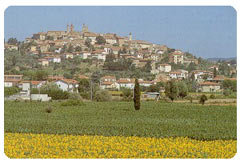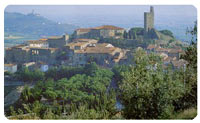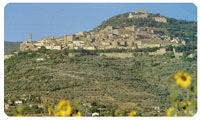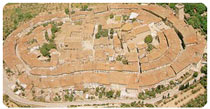Chiana ValleyThis is the most extensive of all the valleys
in the Apennine chain - over 500 sq. kilometres of well organized,
cultivated farm land. A garden when viewed from Cortona, the ancient
city which dominates the entire area from its 600m in altitude. As
early as the 3rd century BC., the valley must have been considered
the granary of Etruria as Hannibal, after plundering and ransacking
the area, was still able to stock his entire army before making his
legendary crossing alluring the Roman legions to Trasimeno where they
were ambushed and defeated.
When Leonardo da Vinci, more than fifteen
centuries later, drew up the "Codice Atlantico" (Atlantic
Code), the Val di Chiana once again appeared as a lake. It so happened
that after the fall of the Western Roman Empire, the ensuing barbarian
invasion and bloody gothic Wars (which continued throughout almost
the entire 6th century) brought about the systematic depopulation
of the country-side. No longer tended with loving care, the Val di
Chiana surrendered yet again to the waters inundating its territory.
Land reclamation planned and carried out by the Aretine engineer,
Vittorio Fossombroni, during the Lorraine rule at the beginning of
the 19th century, restored to the Val di Chiana its former productive
capacity. The valley was soon scattered with villages and architecturally
superb farm-complexes which were higly efficient for the times.
The historic centre consists entirely of
dignified mansions both sacred and secular, among which the most notable
are the Gothic church of San Francesco, the Collegiate church and
the Chiesa del Gesù all of them rich in art works of high value.
Apart from a few Renaissance palaces, the
prevailing character of Cortona's architecture is medieval, conferring
on the steep narrow streets a strong sense of atmosphere. The city
is commandingly situated (altitude 600 metres) and there are magnificent
panoramas to every point of the compass, embracing the whole of the
Val di Chiana.
The dignified air which they impart to
the landscape is reinforced by the monolithic and majestic proportions
of the fortress, and by the Gothic church of San Francesco. Contact us today to rent your villas in Tuscany.
|


|
Choose
your |
|
By Type |
|
By Price Range (*)
|
|
(*) |
|
In the Surroundings |
|
Arezzo Valley |
|
|



